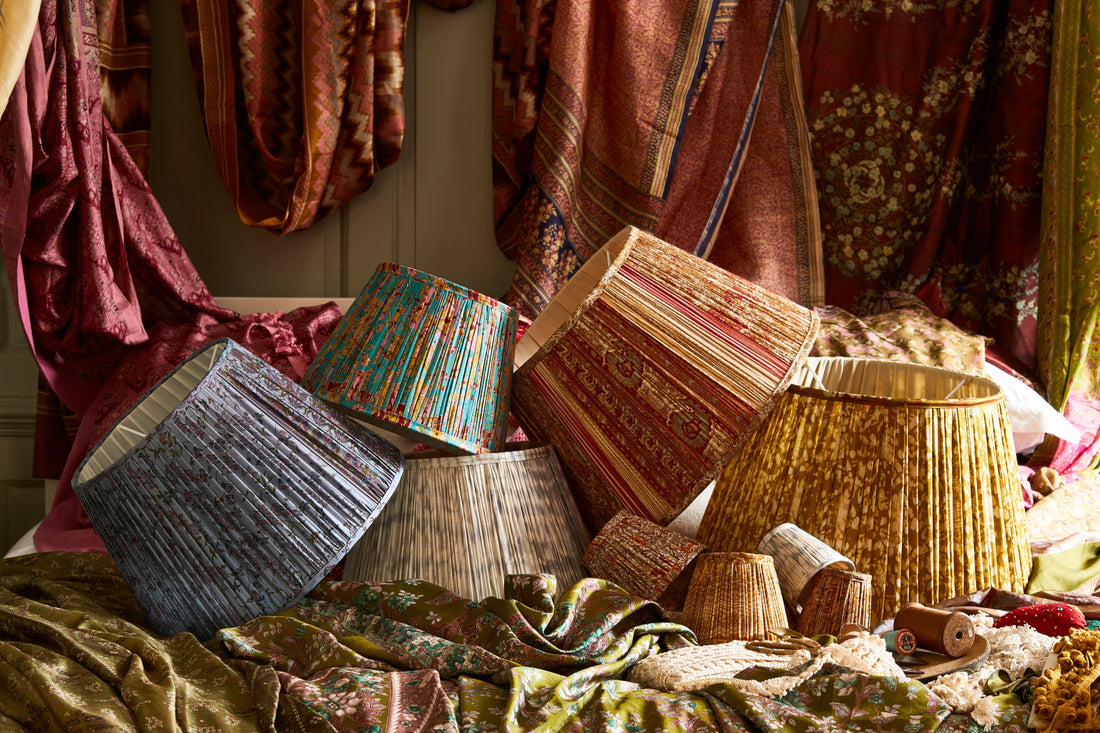In the pursuit of rich textiles and artisanal craftsmanship in the wonderful eclectic markets of India we discovered the most gorgeous vintages sarees and there and then were inspired to create our first collection of unique and beautiful hand pleated silk saree lampshades.
Sarees have a very long standing tradition in India playing a practical role (being warm in winter and cool in summer) as well as a decorative one in women’s attire.
A saree is effectively a drape varying from 4.5 metres (5 yards) to 8 metres (9 yards) in length and 60cm (2ft) to 120cm (4ft) in breadth with more than 80 ways to wear them. Perhaps the most notable sarees are the red ones that symbolise good luck, happiness and prosperity that tend to be worn by brides on their wedding day. Each saree has a pallu which is the decorative end of the drape which hangs loose over the shoulder; this is displayed in many of our lampshades as a panel adding diversity and interest.
Chosen for their jewel-like patterns, colours and textures every saree has a story to tell; below we discover more about the types of silk used for our saree lampshades and where and how they are produced and what makes them so special.
Sambalpuri Saree
A traditional hand woven saree from the state of Odisha in East India the Sambalpuri is a delicate weave of different techniques creating an Ikat pattern that has a curvilinear and feathery appearance. The threads are dyed before they are woven meaning its rich colour will never fade.

Muga Silk Saree
Muga silk from Assam is made from the semi-cultivated silkworm named Antheraea assamensis. Muga silk is one of the rarest in the world and its golden colour and shine being its most unique feature.
Colour is added to the yellowy golden base through rich embroidery in the forms of flowers, leaves, trees and Bihu structures lending a unique and fabulous look.
Patola Silk Saree
Created in Patan, Gujarat, these sarees are hand-woven using a special type of silk called patota. Manufactured by the resist-dyeing process using the warp & weft technique, Patolas are double ikat sarees and are recognisable through their bold outlines, vibrant colours and charming geometrical patterns.

Tussar Silk Saree
Discovered in the medieval times Tussar Silk is an exquisite natural gold thread made by the larvae of several species of silk moths.
Tussar is light and one of the most convenient fabrics to drape. A unique feature of this fabric is the ability to refract different shades at different angles with every movement creating an array of colours.
Kanchipuram Silk Saree
Synonymous with the sarees of South India, the Kanchipaurum silk saree is woven from pure mulberry silk with a pure gold and silver zari (thread) from Gujarat. The sarees are known for their vibrant colours and eye catching designs, which are mainly inspired from the scriptures and figurines from the very many temples in this small village.
The shine, durability, thickness and stiffness of the fabric comes from the fact that the silk thread is dipped in rice water and sun dried before it is interlocked with a thin silver wire and woven through after which a golden thread is used to complete the procedure.
The warp frame use to weave this fabric has about 60 holes, in which there are 240 threads in the warp and 250 to 3000 threads in the weft, giving it a sturdy feel. The pallu, the border and the body of the saree are generally woven separately, and then interlocked together with much precision and neatness.
Bandhani Silk Saree
The face of Gujarati and Rajasthani craft Bandhani sarees are made using a traditional technique of tie dye in which the cloth is plucked with finger nails and tied into small or large dye resist circles depending on the pattern that is desired. Patterns will include a a variety of symbols including dots, waves, strips and squares and are most prominently yellow, red, green, blue and black.

Batik Silk Saree
Having been around for some 2000 years, Batik is truly an ancient form. Batik uses wax resist to create beautiful patterns on cloth and is known for its use of floral motifs and an earthy palette, with an occasional pop of vibrant colour.

References: craftsvilla.com, utsavpedia.com
